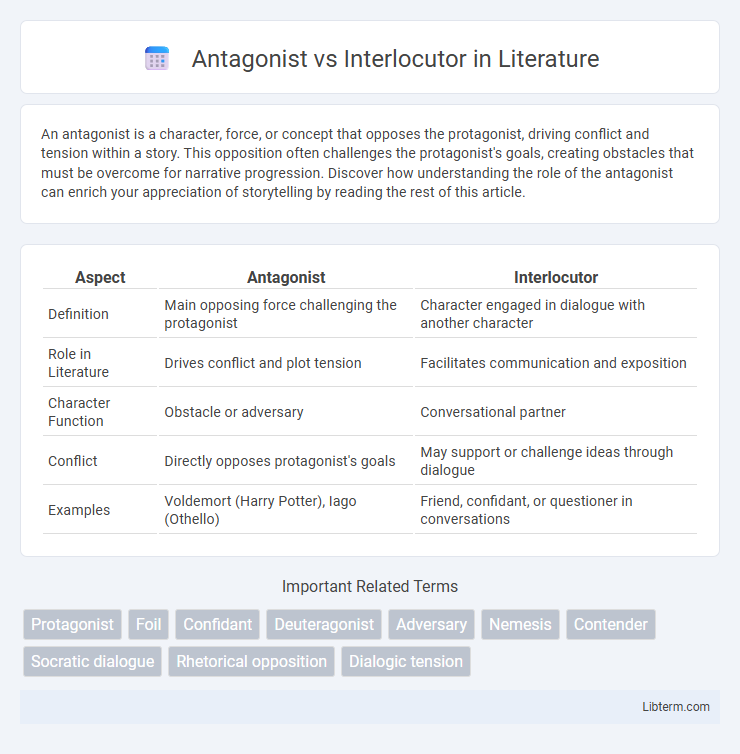An antagonist is a character, force, or concept that opposes the protagonist, driving conflict and tension within a story. This opposition often challenges the protagonist's goals, creating obstacles that must be overcome for narrative progression. Discover how understanding the role of the antagonist can enrich your appreciation of storytelling by reading the rest of this article.
Table of Comparison
| Aspect | Antagonist | Interlocutor |
|---|---|---|
| Definition | Main opposing force challenging the protagonist | Character engaged in dialogue with another character |
| Role in Literature | Drives conflict and plot tension | Facilitates communication and exposition |
| Character Function | Obstacle or adversary | Conversational partner |
| Conflict | Directly opposes protagonist's goals | May support or challenge ideas through dialogue |
| Examples | Voldemort (Harry Potter), Iago (Othello) | Friend, confidant, or questioner in conversations |
Defining Antagonist and Interlocutor
An antagonist is a character or force that opposes the protagonist, creating conflict essential to the narrative's development. An interlocutor is a participant in dialogue, often serving to advance conversation or reveal information between characters. While the antagonist drives tension through opposition, the interlocutor facilitates communication and interaction within the story.
Key Differences Between Antagonist and Interlocutor
The key differences between an antagonist and an interlocutor lie in their roles and functions within communication and narrative contexts. An antagonist typically opposes the protagonist, creating conflict and tension, while an interlocutor serves as a conversational partner or dialogue participant, facilitating exchange and understanding. Unlike antagonists who drive opposition, interlocutors enable interaction and the flow of information through dialogue.
Roles in Narrative Structure
The antagonist functions as the primary opposing force to the protagonist, driving conflict and tension within the narrative through challenges or obstacles. The interlocutor, often a secondary character, serves as a conversational partner or catalyst for revealing the protagonist's thoughts, motivations, and development. While the antagonist embodies external opposition, the interlocutor facilitates internal dialogue and exposition, enriching the story's emotional and psychological depth.
Antagonist: Classic Examples in Literature and Media
Antagonists embody opposition and conflict, crucial for driving narratives in classic literature and media, exemplified by characters like Shakespeare's Iago in "Othello" and Voldemort in the "Harry Potter" series. These figures create tension and challenge protagonists, often symbolizing broader themes such as betrayal, power, or evil. Their presence enhances plot complexity and deepens audience engagement through moral and psychological conflicts.
Interlocutor: Function and Importance
The interlocutor serves as a key participant in dialogue, facilitating communication by actively engaging in the exchange of ideas, questions, and responses. Their function extends beyond mere conversation, acting as a mediator who ensures clarity, comprehension, and progression of the discussion. In both interpersonal and formal settings, the interlocutor's role is crucial for fostering mutual understanding and advancing the conversation toward meaningful outcomes.
Motivations and Objectives
An antagonist drives conflict by opposing the protagonist's goals, often motivated by personal gain, revenge, or ideological beliefs that clash with the main character's objectives. An interlocutor's role centers on communication, aiming to influence, inform, or negotiate between parties, with motivations rooted in clarity, mediation, or persuasion. While the antagonist creates obstacles to challenge the narrative, the interlocutor facilitates dialogue that can lead to understanding or resolution.
Impact on Protagonist’s Development
An antagonist shapes the protagonist's development by introducing conflict and obstacles that challenge their beliefs, forcing growth and adaptation. In contrast, an interlocutor serves as a conversational catalyst, prompting self-reflection and deeper understanding through dialogue. Both roles are crucial, but antagonists primarily drive external change while interlocutors influence internal transformation.
Dialogue Dynamics: Conflict vs Conversation
Antagonists drive dialogue dynamics through conflict, often introducing tension and opposition that fuel plot progression and character development. Interlocutors, however, facilitate conversation by engaging in balanced exchanges that promote understanding and reveal diverse perspectives. The interplay between antagonistic confrontation and interlocutor communication shapes narrative flow, highlighting the contrast between struggle and dialogue.
Misconceptions About Antagonists and Interlocutors
Misconceptions about antagonists often portray them as purely evil characters, ignoring their complex motivations and roles that drive conflict in narratives. Interlocutors are frequently mistaken for passive participants in dialogue, yet they actively shape conversations and influence plot development. Understanding these nuanced roles enhances comprehension of character dynamics and story progression.
Choosing the Right Character for Your Story
Choosing between an antagonist and an interlocutor depends on the narrative purpose and character dynamics in your story. An antagonist typically drives conflict by opposing the protagonist's goals, creating tension and challenges essential for plot development. An interlocutor, often a conversational partner or mediator, facilitates dialogue and exposition, enriching character relationships without necessarily introducing direct conflict.
Antagonist Infographic

 libterm.com
libterm.com